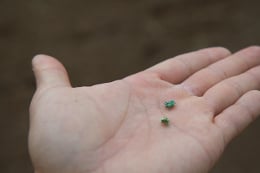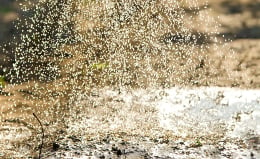How to Plant a Buffalo Grass Lawn
 Buffalo Grass is a great warm-season option for your lawn. It is the only commonly used grass seed type native to North America—and as any gardener would tell you, native plants are easier to take care of than are nonnative plants. Buffalograss is very drought tolerant. It doesn’t need much fertilizer, irrigation, or even mowing. It can even be left uncut for a meadow look. If all of these characteristics have convinced you to plant this species for your lawn, there are some things you’ll need to know about planting it.
Buffalo Grass is a great warm-season option for your lawn. It is the only commonly used grass seed type native to North America—and as any gardener would tell you, native plants are easier to take care of than are nonnative plants. Buffalograss is very drought tolerant. It doesn’t need much fertilizer, irrigation, or even mowing. It can even be left uncut for a meadow look. If all of these characteristics have convinced you to plant this species for your lawn, there are some things you’ll need to know about planting it.
First, pick the right buffalo grass seed product for your lawn. There is a multitude of seed brands out there, all costing a different amount. Before you go grabbing the cheapest bag, however, do yourself a favor and look at the pure live seed percentage. This percentage shows how much of the seed bag contains buffalo grass seed (the purity percentage), and how much of that is actually expected to germinate (the germination percentage). When it comes to the quality of your lawn, it really is better to buy a more expensive seed product that has a higher pure live seed percentage. The result will be a denser, thicker, and higher quality lawn.
To prepare the soil, remove any old plant material or weeds—you don’t want to be dealing with those in a newly established lawn! Till the soil several inches deep to help loosen it, and take this opportunity to add organic material to the soil. Add a pre-plant fertilizer as well, one that is high in phosphorus, a week or two before you plant.
You should wait until soil temperatures are 60 to 70ºF and air temperatures are 70 to 90ºF before you plant this species. When this occurs during the spring season will depend on your region, so buy a special soil thermometer to get exact measurements.
Usually you will only have to seed buffalograss at a rate of 1 ½ to 2 lbs. per 1,000 sq. ft, but check the seeding rate recommendations to make sure. Measure your lawn to know the total amount you should have. A drop spreader will improve evenness, but you can also seed by hand or with a shoulder spreader. Take half of the total seed amount and spread it back and forth across the lawn in a horizontal direction. Then take the other half spread it in a vertical direction. Use a lawn roller to gently firm up the soil and ensure good soil contact, keeping in mind that the seeds should be no deeper than ¼” in the soil.
 At this point you will need to be patient. This species can take as many as 14 to 30 days to germinate. Until that happens, you will need to keep the soil lightly moist, watering briefly and often, as many as five times a day. Once you start seeing small green shoots, continue watering this way for another two weeks. After that, you can begin watering deeply and infrequently to help the root system grow.
At this point you will need to be patient. This species can take as many as 14 to 30 days to germinate. Until that happens, you will need to keep the soil lightly moist, watering briefly and often, as many as five times a day. Once you start seeing small green shoots, continue watering this way for another two weeks. After that, you can begin watering deeply and infrequently to help the root system grow.
Let your new buffalo grass lawn grow for another four to eight weeks before you do a fertilizer application (about ¼ to ½ lb. nitrogen per 1,000 sq. ft.). Apply again every six to eight weeks during the growing season, or when the lawn is looking yellow. Remember that this native grass will not need much fertilizer, so don’t overdo it. Soon you will be able to enjoy a fully established buffalograss lawn.
